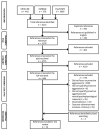Cold-Blooded and on Purpose: A Review of the Biology of Proactive Aggression
- PMID: 34827411
- PMCID: PMC8615983
- DOI: 10.3390/brainsci11111412
Cold-Blooded and on Purpose: A Review of the Biology of Proactive Aggression
Abstract
Proactive aggression (PA) is a planned and unprovoked form of aggression that is most often enacted for personal gain or in anticipation of a reward. Frequently described as "cold-blooded" or goal oriented, PA is thought to be associated with low autonomic arousal. With this view in mind, we performed a scoping review of the biological correlates of PA and identified 74 relevant articles. Physiological findings indicated a robust association between PA and reduced resting heart rate, and to a lesser extent a relationship between PA and decreased heart rate and skin conductance reactivity, perhaps indicating dampened sympathetic function. The twin literature identified PA as a heritable trait, but little evidence implicates specific genes in the pathogenesis of PA. Neuroimaging studies of PA pinpoint impaired amygdala function in the assessment and conditioning of aversive stimuli, which may influence the establishment of behavioral patterns. Nodes of the default mode network were identified as possible neural correlates of PA, suggesting that altered function of this network may be involved in the genesis of PA. Given the overlap of PA with reactive aggression and the overall behavioral complexity of PA, it is clear that multiple endophenotypes of PA exist. This comprehensive review surveys the most salient neurobiologically informed research on PA.
Keywords: HPA axis; autonomic function; event-related potentials; molecular genetics; neuroimaging; proactive aggression; twin studies.
Conflict of interest statement
The authors declare no conflict of interest.
Figures


Similar articles
-
Being hot-tempered: autonomic, emotional, and behavioral distinctions between childhood reactive and proactive aggression.Biol Psychol. 2010 Jul;84(3):488-96. doi: 10.1016/j.biopsycho.2009.11.006. Epub 2009 Nov 24. Biol Psychol. 2010. PMID: 19941933
-
Autonomic conditioning to monetary and social stimuli and aggression in children.Aggress Behav. 2018 Mar;44(2):147-155. doi: 10.1002/ab.21738. Epub 2017 Nov 3. Aggress Behav. 2018. PMID: 29098703 Free PMC article.
-
Skin conductance, heart rate and aggressive behavior type.Biol Psychol. 2019 Feb;141:44-51. doi: 10.1016/j.biopsycho.2018.12.012. Epub 2018 Dec 22. Biol Psychol. 2019. PMID: 30584895
-
Psychophysiology of anger and violent behavior.Psychiatr Clin North Am. 1997 Jun;20(2):375-94. doi: 10.1016/s0193-953x(05)70318-x. Psychiatr Clin North Am. 1997. PMID: 9196920 Review.
-
Non-angry aggressive arousal and angriffsberietschaft: A narrative review of the phenomenology and physiology of proactive/offensive aggression motivation and escalation in people and other animals.Neurosci Biobehav Rev. 2023 Apr;147:105110. doi: 10.1016/j.neubiorev.2023.105110. Epub 2023 Feb 21. Neurosci Biobehav Rev. 2023. PMID: 36822384 Review.
Cited by
-
Aggression, Aggression-Related Psychopathologies and Their Models.Front Behav Neurosci. 2022 Jul 4;16:936105. doi: 10.3389/fnbeh.2022.936105. eCollection 2022. Front Behav Neurosci. 2022. PMID: 35860723 Free PMC article. Review.
-
Associations between Omega-3 Index, Dopaminergic Genetic Variants and Aggressive and Metacognitive Traits: A Study in Adult Male Prisoners.Nutrients. 2022 Mar 25;14(7):1379. doi: 10.3390/nu14071379. Nutrients. 2022. PMID: 35405990 Free PMC article.
-
Dimensions of Pathological Aggression: From Neurobiology to Therapy.Brain Sci. 2022 Mar 3;12(3):347. doi: 10.3390/brainsci12030347. Brain Sci. 2022. PMID: 35326303 Free PMC article.
-
Non-Invasive Brain Stimulation for the Modulation of Aggressive Behavior-A Systematic Review of Randomized Sham-Controlled Studies.Life (Basel). 2023 May 20;13(5):1220. doi: 10.3390/life13051220. Life (Basel). 2023. PMID: 37240865 Free PMC article. Review.
-
MAOA methylation is associated with impulsive and antisocial behaviour: dependence on allelic variation, family environment and diet.J Neural Transm (Vienna). 2024 Jan;131(1):59-71. doi: 10.1007/s00702-023-02675-w. Epub 2023 Jul 29. J Neural Transm (Vienna). 2024. PMID: 37507512
References
-
- Coccaro E.F., McCloskey M.S. Aggression: Clinical Features and Treatment across the Diagnostic Spectrum. American Psychiatric Publishing; Washington, DC, USA: 2018.
-
- Geen R.G. Human Aggression. Brooks/Cole Publishing Company; Pacific Grove, CA, USA: 1990.
-
- Brenner M.H. Estimating the Social Costs of National Economic Policy: Implications for Mental and Physical Health, and Criminal Aggression: A Study Prepared for the Use of the Joint Economic Committee. US Government Printing Office; Washington, DC, USA: 1976.
-
- Dodge K.A. The Structure and Function of Reactive and Proactive Aggression. In: Pepler D.J., Rubin K.H., editors. The Development and Treatment of Childhood Aggression. Psychology Press; New York, NY, USA: 1991. pp. 201–218.
Publication types
Grants and funding
LinkOut - more resources
Full Text Sources

